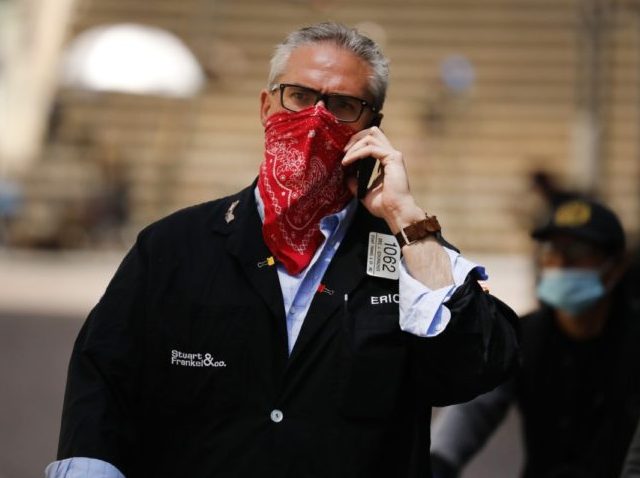U.S. stocks surged upward again Wednesday, producing a second consecutive day of more than a 500 point gain in the Dow Jones Industrial Average.
Financials, industrials, and retailers led the way, while technology and communication stocks lagged, a reversal of the pattern that has held for months. That is likely an indication that investors are feeling more confident about the economy.
The Dow’s 549.8 point gain pushed the index up 2.2 percent for the day to 25,544, the first close above 25,000 since March. The S&P 500 rose 1.48 percent. The Nasdaq Composite, which has risen sharply in recent weeks, was up a more modest 0.77 percent. The Russell 2000 index of smaller public companies, which has been particularly hurt by the pandemic, rose by just over three percent.
Banks and retailers were posting strong gains on hopes that life can inch back toward normal as governments relax stay-at-home orders, after plummeting to some of the market’s worst losses earlier this year when worries about the recession were peaking.
Losses for big tech stocks and other, earlier winners of the stay-at-home economy were holding the gains in check Wednesday. They’re also some of the most valuable companies in the stock market, which gives their movements outsized sway.
The latest gains had the market on track for a three-day winning streak.
“Today is a little bit of a follow-through from yesterday,” said Bill Northey, senior investment director at U.S. Bank Wealth Management. “This is optimism about the reopening of the U.S. economy and, really, the global economy.”
The movements followed up on strong gains in Europe, where authorities proposed a 750 billion euro ($825 billion) recovery fund to help carry the region through the recession caused by the response to the coronavirus pandemic. Asian stocks were mixed, as tensions between the United States and China over the independence of Hong Kong weighed on markets there.
The S&P 500 is back to where it was in early March, in the early days of its sell-off on worries about the coming steep recession. It’s now down only about 10 percent from its high in February, recovering from a nearly 34 percent drop in March.
Massive amounts of stimulus for the economy from the Federal Reserve and Capitol Hill helped start the rally in late March. The gains have accelerated more recently on hopes that economic growth can return later this year as governments ease up on business-shutdown orders meant to slow the spread of the coronavirus. In recent weeks, stocks whose profits are most closely tied to the strength of the economy have been showing more life.
Hopes for potential COVID-19 vaccines under development have also helped propel stocks.
“There’s still so much stimulus, and with consumers being in better shape, we will get through this sooner than most expect,” said Andrew Smith, chief investment strategist at Delos Capital Advisors.
Nordstrom jumped 15.3 percent for one of the strongest gains in the S&P 500, as retailers helped lead the way on hopes that reopening economies will mean more people heading back to stores. Gap vaulted 18.6 percent and Kohl’s climbed 14.5 percent. Macy’s shares rose 19.6 percent.
Banks were also stronger on hopes that business reopenings could limit the wave of loan defaults that investors had been worrying about. Financial stocks in the S&P 500 rose 4.53 percent for the largest gain among the 11 sectors that make up the index.
JPMorgan Chase rose 5.79 percent, Bank of America gained 7.0 percent and Citigroup jumped 8.5 percent.
But investors were less enthusiastic about the big tech stocks that have been market leaders, rising even when the market was selling off. The information technology sector of the S&P, up 13 percent so far this year, rose 0.54 percent.
Microsoft were down most of the day but closed just barely in the green with a gain of 0.13 percent. Amazon lost nearly 0.5 percent and Nvidia dropped 2.4 percent. All three, though, remain up at least 14 percent for the year so far.
In Europe, Germany’s DAX returned 1.3 percent and France’s CAC 40 rose 1.8 percent after the announcement of the region’s recovery fund. The president of the European Commission called it “an ambitious answer,” though it still needs to be endorsed by every country in the European Union. About two thirds of the fund would take the form of grants, while the rest would be loans.
In Asia, Japan’s Nikkei 225 rose 0.7 percent, but other markets were weaker. The Hang Seng in Hong Kong slipped 0.4 percent, and stocks in Shanghai lost 0.3 percent. U.S. officials have been critical of China’s response to the coronavirus outbreak, and the latest front in increased tensions between the two centers on China’s control over Hong Kong.
In the bond market, the yield on the 10-year Treasury note fell to 0.68 percent from 0.69 percent late Tuesday.
U.S. crude oil for delivery in July fell 4.7 percent to $32.73 per barrel. Brent crude, the international standard, lost 0.1 percent to $35.40 per barrel.
–The Associated Press contributed to this report.

COMMENTS
Please let us know if you're having issues with commenting.